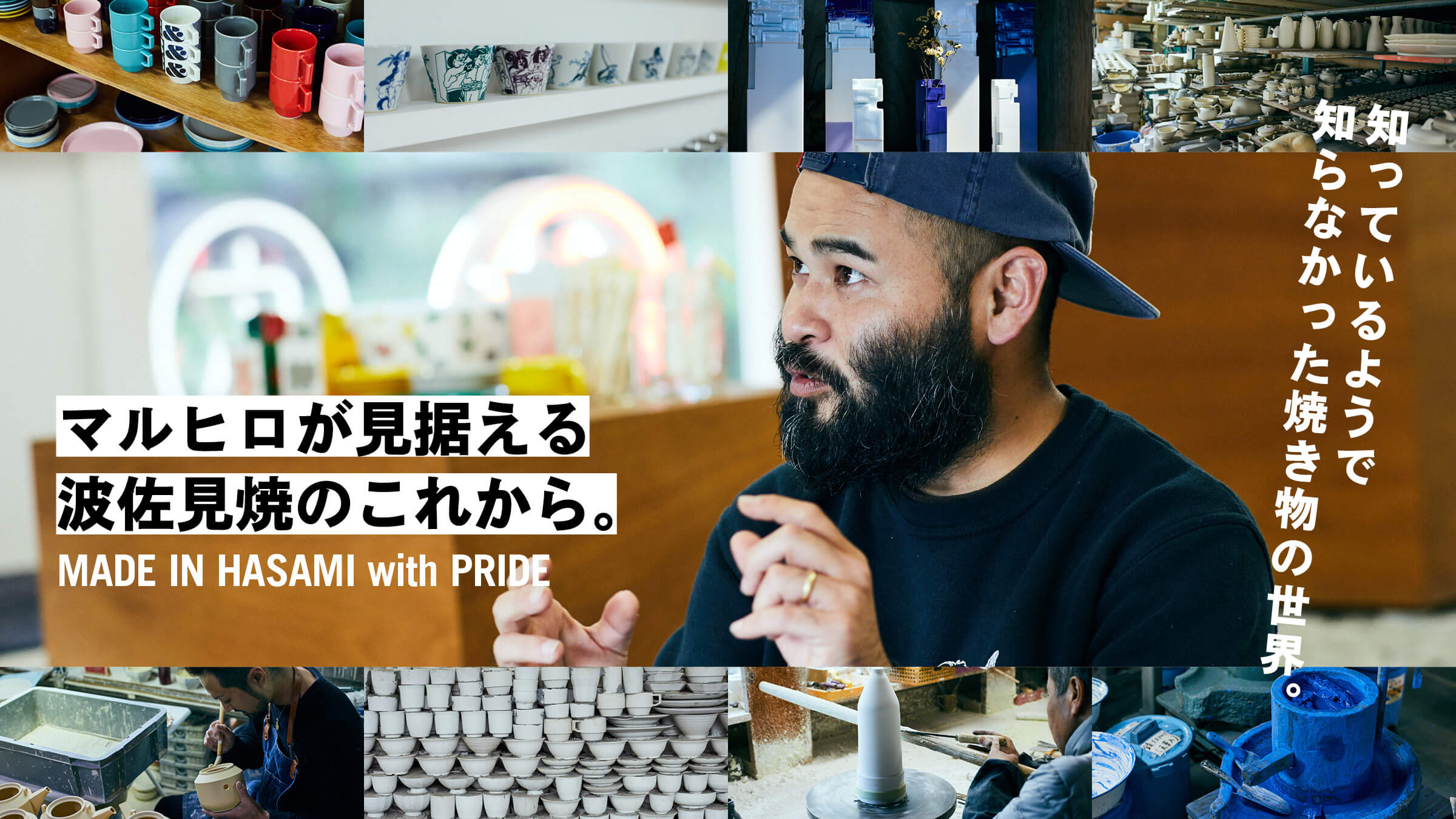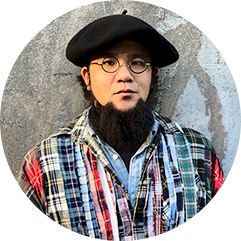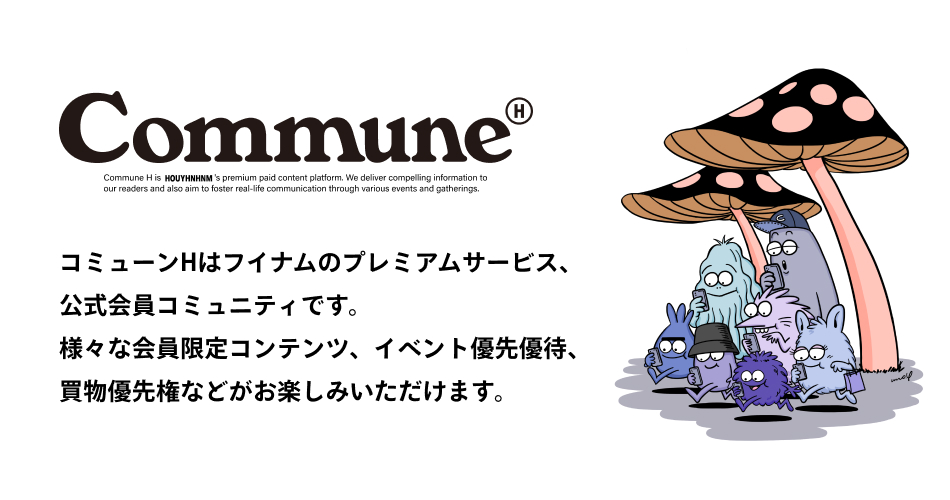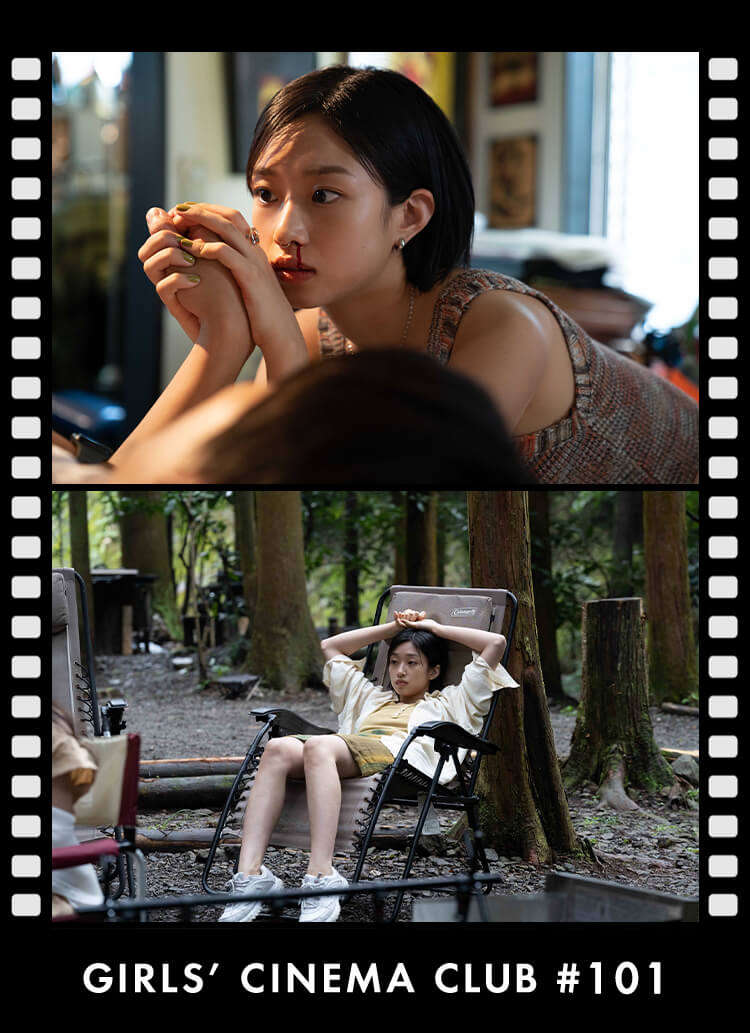It may seem shallow, but it is deep. Such depth is the charm of Hasami-ware.
The finished pottery is inspected by the trading company one by one for cracks and splits, and then distributed to various stores, but "MARUHIRO" also has a directly managed store where it is sold. Let Mr. Baba talk about "Maruhiro" and his passion for Hasami-ware.

Baba-san is the third generation of "MARUHIRO", isn't he? How did the company start?
Baba:It originally started as a street vendor. It was my grandfather's generation, so it was about 50 years ago. At that time, we dealt in what were called "gasamono. These were things like chipped tea bowls with chipped tops and mouths, which were treated like trash by the kiln makers and were destined to be thrown away. We bought them, polished the chipped parts, and sold them at a discount.
You didn't start out dealing in "A" products, did you?
Baba:It was after the bursting of the bubble economy that we began to make "A" products. Suddenly, things were not selling well, and manufacturing demanded precision. So, it became difficult to obtain cheap products, and we had no choice but to make "A" products. However, even so, they still did not sell well. That was about 14 years ago.
Was that Baba's idea?
Baba:No, it was my father. My father read a book by Masashichi Nakagawa titled "How a Small Company in Nara Opened a Shop in Omotesando Hills" and contacted Mr. Nakagawa's company. At the time, Nakagawa Masashichi Shoten's business was growing tremendously, and in the book, there was a line that said, "I want to share my knowledge with people who deal with traditional crafts. So I actually met with Mr. Nakagawa and asked him about my father's desire to create his own brand.

The store floor is uniquely decorated with about 25,000 pieces of Hasami-ware stacked in layers, with fixtures and other items arranged on top of them.
I see. Is that where Baba-san gets involved?
Baba:That's right. I was suddenly thrown into launching a brand (laughs).
I didn't realize it was on such short notice (laughs).
Baba:After about a year of preparation, I presented my first product at a large joint exhibition called "Interior Lifestyle" in 2010. I had never made pottery before, so I started by making mugs while consulting with Baba-san, the potter, and Kikumi-san, the moldmaker.

From left: [HASAMI × HOUSE INDUSTRIES] block mug ¥2,000 + tax, [HASAMI] block mug grittle ¥1,000 + tax,
Block mug big ¥1,800 + tax, block mug (both pink and blue) ¥1,500 + tax
The "block mug" is a standard item of HASAMI, an original brand of MARUHIRO.
The fabric is formed thicker and is made by applying heat and pressure, making it durable.
The patterned item on the left is a collaboration with House Industries, an American font design office.
Why did you choose the mug?
Baba:That was Mr. Nakagawa's subject. There are many recycle stores around here, so I started by buying everything I could find for about 100 yen and learning what designs were good. I also went around to the ladies in the neighborhood and asked their opinions on what kind of products are easy to use. I also asked the ladies in my neighborhood what they thought was easy to use. They said, "We don't want to take up too much space," so I made Hasami-ware that can be stacked and stored.
Wow! So you decided on the design while moving your feet?
Baba:When Mr. Nakagawa asked me, "What kind of brand do you want? At first, without thinking, I answered, "I want to make a brand that will always be placed in Nakagawa Masashichi Shoten. I thought if I did that, I wouldn't lose my job (laughs). (Laughs.) But one of the employees asked me, "Are you sure you can keep doing that? (laugh). I don't have the same lifestyle as Mr. Nakagawa, and I don't understand everything about Hasami-ware. I don't have the same lifestyle as Mr. Nakagawa, and I don't understand everything about Hasami pottery. Looking back on it now, it was a big moment for me to realize that I had to rethink my direction.

(BARBAR) Iroe small dish ¥1,200 + tax, Iroe soba-no-inokuchi (buckwheat noodle cup) ¥1,800 + tax each,
Chrysanthemum-shaped bowl in overglaze enamels (medium) ¥2,300+tax, Chrysanthemum-shaped bowl in overglaze enamels (small) ¥1,400+tax
BARBAR" is a technology cultivated in the field, a timeless charm that has remained unchanged over time,
Tableware made by combining free and out-of-the-box ideas.
While inheriting the traditional Japanese tableware style, the motifs depicted on the tableware are somehow pop and cute.
Did you add more and more brands as you went along?
Baba:That's right. I started with the "Scissors" brand, and then my father also had a Japanese tableware brand, so I leveraged that as well and started with two brands. I started with two brands, and then I had opportunities to collaborate with many different people.
Q: Who was the first person you collaborated with?
Baba:I met Shuntaro Takeuchi at an exhibition called "Place and Room" at Spiral Hall in Omotesando in 2010. In 2010, I held an exhibition called "Place and Room" at Spiral Hall in Omotesando, where Shuntaro was also exhibiting. Shuntaro was also exhibiting there. (laughs). I talked to him and we became good friends, and we hung out together throughout my stay in Tokyo. We ended up making Hasami-yaki together.

HASAMI × Shuntaro Takeuchi] ant set ¥4,200 + tax, [BARBAR × Shuntaro Takeuchi] soba choko ¥2,000 + tax each
Collaboration with illustrator Shuntaro Takeuchi.
This year's annual series, themed on the great American figures of the 1960s, is inspired by Muhammad Ali.
Soba-no-kuchi buckwheat noodle cups are decorated with Japanese patterns such as Sumo and Fuji with Takeuchi's typical touch, but some of the illustrations are humorous.
It was an unexpected encounter.
Baba:That's right. That led me to release an item once a year with a motif of a great American figure. I was approached by more and more people from all walks of life after seeing those items.

Non-cherry buckwheat choko ¥2,000+TAX
Besides Mr. Takeuchi, you have collaborated with other unique creators such as NONCHERRY and POPPY OIL. Baba's taste is evident in these collaborations.
Baba:We are simply working with people we are good friends with. We exhibited at "Interior Lifestyle" the year before the one I mentioned earlier. There were about 20,000 visitors, but I exchanged business cards with only five people that year (laughs). (Laughs) The reason for this was that there was no link between myself and what was on display there. So, whether you are a craftsman or a creator, it is better to make pottery with people you can trust and sell it with, so that you can naturally put your feelings into it when explaining your work.
So when the idea of collaboration comes up, I try to have them come here first. When they get to know Hasami-yaki and meet the artisans, they are all quite impressed (laughs). (laughs) In this way, we are building a relationship of trust.
I was also able to sense the strong relationship of trust between Mr. Baba and his craftsmen through this interview. I was very impressed when he said, "I often visit the factory instead of staying at the office.
Baba:To be honest, I don't have a job even if I stay at the company (laughs). (Laughs.) Besides, it is easier for the employees to work there. Also, it is better to talk face to face than to simply talk by e-mail or telephone, so that we can adjust our sensitivity to each other. It is more pleasant to talk face to face, isn't it? And when I visit the craftspeople, I can get information on new techniques and various other things.
I also like to do some thinking while riding in the car. Ideas come to me, and I think about how to use those ideas. I think more smoothly when I am driving.

KEEPWARE 25cm plate ¥3,000+tax each, KEEPWARE 21cm plate ¥2,000+tax each,
KEEPWARE 15cm bowl ¥1,500 + tax, KEEPWARE 500cc cup ¥2,000 + tax, KEEPWARE 250cc cup ¥1,500 + tax
A variety of humorous tableware in the form of paper plates and cups.
Baba says, "We sampled the most abundant tableware in the world.
Another key point is that it is finished as thin as paper to the utmost limit in pursuit of realism.
The tableware sold at "MARUHIRO" overturns the stereotype of "pottery = Japanese tableware," doesn't it? Was this your original intention?
Baba:Not at all (laughs). (Laughs) I made what I wanted to make. Even though I have been in the business since my grandfather's generation, I was not that interested in pottery at first, and I did not have any knowledge about it. Perhaps that is why I was able to say some outrageous things to the old craftsmen.
It was a boldness born of ignorance.
Baba:That's right (laughs). (Laughs.) At first, I was told all kinds of things about my unreasonable demands, but when I told them what I wanted to do, they gave me advice. But they were not doing it for me, but for the Hasami pottery industry as a whole. They said, "Your grandfather and father took care of you, so do for the next generation what we did for you.
K.- Art pieces such as the Black Eyepatch bottle and Nike's Air Force One, which you showed us in this interview, take a lot of time and effort to make, don't they? Why do you make such things?
Baba:To which I also asked, "Why bother to make such a thing?" But I would be happy if more people became interested in Hasami-yaki through that. But I would be happy if more people became interested in Hasami-yaki through this product. Besides, I was confident that the old craftsmen had the wisdom and skills to do even difficult things. If someone like me did not take on this kind of work, the skill level of the craftsmen would remain constant. But everyone was surprisingly enjoying the work.

What do you want to do in the future?
Baba:We are actually planning to build a large park in Hasami Town. We bought a piece of land and put it under private ownership.
Why the park?
Baba:There are no parks around here where children can play. So we want to build a park and create a place where everyone can play together. I think that if we can create a new culture from scratch that has never existed in Hasami Town before by involving people who share the same interests and backgrounds as I mentioned earlier, we can create a culture that has never existed in Hasami Town before. In this way, I would like to create a large community in the town as a whole.
Lastly, what do you think is the appeal of pottery, and how does Baba feel about it?
Baba:Pottery has meaning in its shape, and as you may have sensed when you saw the work, there are parts that are difficult, such as shrinking after firing and glazing. But on the other hand, even children can easily make clay pots by kneading them. The more I think about it, the more difficult it seems, but on the other hand, there is also an ease in doing it without thinking about it, and I think that kind of ambiguity or broadness is interesting.
Furthermore, if we talk only about Hasami-ware, I like the fact that it has a bit of a dull smell. However, it is made by people who work hard and sweat hard. The more you get to know the people, the more you can see this reflected in their work. It seems shallow, but it is deep. I think such depth is the charm of Hasami pottery.

When one hears the term "mass production," one tends to associate it with formative machine production. However, as you can see, this is not the case with Hasami-yaki. Starting from mold making, to fabric makers, glaze makers, potters, and trading companies, a lot of people's skills and ideas are poured into this process. According to Baba, "70% of the production process is done by hand. The dishes made in this way support people's daily lives on dinner tables all over Japan.
On the other hand, they are also taking a new approach while utilizing the techniques they have cultivated so far. You will be able to see many art pieces made of Hasami-yaki that break the concept of "pottery = Japanese tableware" at many exhibitions in the future. Of course, you can also casually enjoy it with a variety of modern tableware created by "MARUHIRO.
Despite its familiarity, Hasami-ware has never been well known. Why not take this opportunity to step into the profound world of Hasami-ware?









